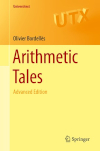- About MAA
- Membership
- MAA Publications
- Periodicals
- Blogs
- MAA Book Series
- MAA Press (an imprint of the AMS)
- MAA Notes
- MAA Reviews
- Mathematical Communication
- Information for Libraries
- Author Resources
- Advertise with MAA
- Meetings
- Competitions
- Programs
- Communities
- MAA Sections
- SIGMAA
- MAA Connect
- Students
- MAA Awards
- Awards Booklets
- Writing Awards
- Teaching Awards
- Service Awards
- Research Awards
- Lecture Awards
- Putnam Competition Individual and Team Winners
- D. E. Shaw Group AMC 8 Awards & Certificates
- Maryam Mirzakhani AMC 10 A Awards & Certificates
- Two Sigma AMC 10 B Awards & Certificates
- Jane Street AMC 12 A Awards & Certificates
- Akamai AMC 12 B Awards & Certificates
- High School Teachers
- News
You are here
Arithmetic Tales: Advanced Edition

Publisher:
Springer
Publication Date:
2020
Number of Pages:
801
Format:
Paperback
Edition:
2nd
Series:
Universitext
Price:
84.99
ISBN:
978-3-030-54945-9
Category:
Textbook
[Reviewed by , on ]
Michael Berg
01/30/2022
What’s not to like about Olivier Bordelles’ Arithmetic Tales (Advanced Edition)? In a word, nothing. It’s a gem --- modulo the propositions that (1) you really like number theory (well, you need to love it, but my claim is that number theory is eminently loveable), (2) you’re willing to work hard playing with the material (and the harder you work, the better you get, and the better the book will be for you), and (3) you come to the game prepared. What does (3) mean? Well, the answer is found in connection with Bordelles’ codicil that this is an “advanced edition,” suggesting there is a not-so-advanced version out there. And that would be the book’s earlier edition, about which Bordelles says that he has removed all “chapters devoted to the knowledge required from undergraduate mathematics students … with only the most necessary overlapping content completely rewritten in summarized form.” Aha! This is truly beginning to look like an advanced text, and, indeed, Bordelles removes all doubt with his next sentence: “The prerequisites for this second edition are therefore essentially all known results in classic elementary number theory.” But this does kick the can down the road a little: what’s classic elementary number theory? Well, when I was a kid, in the dark ages, “elementary” referred to having nothing at the level of, or more serious than, complex analysis present (and this also makes elementary number theory uniquely intricate and difficult, sometimes: consider the “elementary” proof of the prime number theory due (essentially independently) to Selberg and Erdos). I guess this is still a pretty good rule of thumb. Two books come to mind immediately in this connection: Edmund Landau’s still unsurpassed Elementary Number Theory (which contains a lot more than most courses with that title would offer) and Hardy and Wright's Introduction to the Theory of Numbers (ditto). A modern book I like a great deal is Harold Stark’s An Introduction to Number Theory (which he aimed at other than just future number theorists, interestingly enough).
All right, what about Bordelles’s advanced text proper, then? Well, I think it is fabulous. He notes at the outset that Zhang’s recent result in bounded gaps between successive primes is of huge importance, and he gives a sketch of Zhang’s “breakthrough” on pp. 298-299. Of course, Zhang’s proof itself is absent (go to his 2014 paper for that), but we should note the context of Bordelles’ discussion: “selected problems in multiplicative number theory,” with the theorem of Bombieri-Vinogradov on stage. Bordelles notes in the Preface that Zhang’s proof includes a “suitable extension” of this theorem. And we get a sense of what this book is all about: let’s get to the frontier and do it in a thorough and responsible fashion. Apropos, it is always worth noting that the apotheosis of the results of Zhang type, so to speak, is the twin primes conjecture.
That said, a glance at the table of contents provides something of an atlas of where we’ll be traveling: diophantine equations, prime numbers (including Dirichlet L-functions, PNT (all right … the Prime Number Theorem), and (sans proof, if I may put it so) RH (i.e. the Riemann Hypothesis), arithmetic functions (up to sieve methods (Bombieri is smiling) and the stuff mentioned in the preceding paragraph). Next, Bordelles goes on to a subject that, in my opinion, is not given enough airplay (so kudos to Bordelles): lattice points. The last two chapters deal with, respectively, exponential sums (and we meet Hardy-Littlewood and their circle method there, for example), and, finally, algebraic number fields. This last chapter is of course concerned with material that is frequently given in the setting of an autonomous course; very nicely, it is all there in Bordelles’ book, on a par with, say, Pierre Samuel’s Algebraic Theory of Numbers or even Lang’s Algebraic Number Theory. Actually, I think that Bordelles’s treatment is less far-reaching than what is in texts devoted explicitly to this latter subject (Lang is more expansive, for example), for good reason. But he does include material on ramification, class field theory, etc.
It’s a big book (almost 800 pages), with long chapters with many (exciting) subsections. There are a lot of problems to do (and, yes, do them); there are hints and answers in the back. The book is very well-written, doing a lot of deep stuff in detail and continually providing discussions of recent results, open questions, and so on. There are fantastic lists of references after each chapter. And Bordelles is kind enough to provide a first chapter on basic tools that comprises a nice vade mecum for at least some of what is ahead.
It’s a wonderful book.
Michael Berg is Professor of Mathematics at Loyola Marymount University in Los Angeles, CA.
See the publisher's website.
- Log in to post comments




